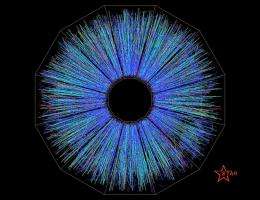Grant advances quark-gluon plasma studies

Rice University's Bonner Nuclear Lab has won a $1.175 million grant that will support its research on high-density and hot nuclear matter.
Rice physicist Frank Geurts, who has spent his career looking for clues to the basic elements of the universe by smashing the nuclear contents of gold, lead and other heavy atoms, said the Department of Energy grant will facilitate his group's transition from constructing and commissioning a highly complex detector system to using that machinery to do basic research.
Much of the Bonner Lab's focus over the past two decades has been on the Solenoidal Tracker at the Relativistic Heavy Ion Collider (RHIC), a particle accelerator for nuclear physics research at Brookhaven National Laboratory in New York.
A device known as STAR (short for Solenoidal Tracker at RHIC) has been taking data at Brookhaven since 1999. Rice designed and built essential components for STAR, which helps detect and study the subatomic particles released when heavy nuclei collide at nearly the speed of light.
In 2005, RHIC announced the breakthrough discovery of a quark-gluon plasma, a dense, high-energy state of matter believed to have existed in the first milliseconds after the Big Bang. Scientists referred to the very hot material created in the lab -- 150,000 times hotter than the sun's core -- as a "perfect liquid," one with practically no viscosity, or as little as quantum physics will allow. Such properties were quite a surprise, Geurts said, because original expectations were that this phase of matter would behave much more like a gas.
The main component of STAR, the time projection chamber (TPC), "gives us a 3-D 80-megapixel picture for every collision, and that allows us to know the charge of the particles, the momentum of the particles and to some degree the identity of those particles," said Geurts, assistant professor of physics and astronomy.
The roughly 14-foot-long, 13-foot-wide cylinder is a gas-filled chamber surrounded by a powerful magnet that captures images of particles, which look like contrails from a high-flying jet. The particles zoom off in every direction from the collision of heavy nuclei, usually gold. Those collisions happen inside the accelerator that runs through STAR's center.
In recent years, the team that includes William Llope, a senior faculty fellow in physics and astronomy, and Geary Eppley, a Rice research scientist, has worked to extend STAR's particle identification abilities by cladding it with a layer of 23,000 sensors collectively known as the time-of-flight (TOF) detector. It will tell researchers how long the most robust particles take to fly through the TPC. "It acts as a fancy -- and highly accurate -- stopwatch," Geurts said. "The TPC gives us all the details of the momentum and path traveled by the emerging particles, and the new detector provides us with the time it took them to travel that far. We can then calculate what the mass of that particle is."
The new detector is accurate to a 10th of a billionth of a second, he said. "People are very excited about this because we will be able to identify about 96 percent of the particles that come out of collisions." In fact, the new sensors will allow the characterization of subatomic particles out to higher momenta. "This allows us to peek deeper into the hot and dense matter," said Geurts, who has also worked extensively at the Large Hadron Collider, an even bigger new accelerator in Europe that has started to smash heavy nuclei at even higher energies.
With completion of the 10-year time-of-flight project this fall, Geurts said the Bonner Lab is shifting its priorities from constructing the subdetector for STAR to analyzing the data it produces and reaping the exciting results. While STAR has been upgraded, so will other components at RHIC, including the addition of a new firing mechanism that will give the collider the ability to handle uranium nuclei and perhaps other heavy nuclei.
The DOE grant provides the Bonner Lab the opportunity to analyze all the data these new tools will make available. "The group has invested a lot of effort to develop the detectors and has vast experience in successfully operating such devices. Now we can switch from commissioning this new detector to doing the physics it makes possible," Geurts said.
"We understand this hardware better than anyone else, so we're in a good position to use the detector to provide researchers with well-identified particles. On the other hand, we are still committed to improving the detection capabilities of the STAR experiment by researching the addition of new components." Recently, Geurts' group took a leadership role in the proposed research, development and construction of a new subdetector that will use techniques similar to those in the TOF detector, but geared toward the detection of muons, electrons' heavier siblings.
Current experiments at RHIC include efforts to map out the phase diagram of hot and dense matter and to look for its critical point. "With RHIC lowering its beam energies, we are now able to answer questions that Hadron cannot answer," Geurts said. He is particularly interested in the movement of quarks and gluons inside the liquid, which will provide clues to the early state of the universe before all those particles began to coalesce into matter.
Provided by Rice University




















